Holy Trinity Church is situated near the centre of Aberystwyth. The men of its Parish who fell during both World Wars are commemorated on two separate memorials inside the church; a brass plaque for the fallen of the Great War, and a stone memorial for the fallen of the Second World War. The brass memorial was unveiled in September 1920 by Lieutenant-Colonel Lewis Pugh Evans VC, DSO and the dedication performed by the Bishop of Swansea. The photograph of the memorial is courtesy of Gil Jones, while most of the portraits of the men are courtesy of Ceredigion Archives.
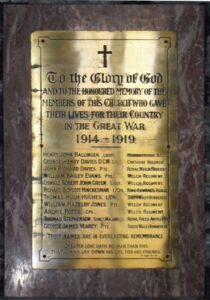
The Great War 1914-1918
Henry John Ballinger, Second Lieutenant, Monmouthshire Regiment. Henry was born on 23 June 1896, the son of John Ballinger (Librarian at the NLW) and Amy Amelia Ballinger, of Sherborne House, Aberystwyth. Educated at Cowbridge School and St. Paul’s School, he enlisted at the outbreak of war into the Royal Welsh Fusiliers. Henry was commissioned on 22 April 1915 into the Monmouthshire Regiment, and went to France on 19 July 1915, where he was posted to the 1st Battalion, Monmouthshire Regiment. The Battalion was attached to 84 Brigade, 28th Division, but on 3 September 1915 joined the 46th (North Midland) Division, as the Divisional Pioneer Battalion. On 13 October 1915, the Division was sent to attack the Hohenzollern Redoubt, at Loos, a maze of trenches, wire and fortifications, which had been the keystone of the German defences. During the fighting, the Monmouth’s entered the German trenches, and whilst attempting to manoeuvre some captured German machine-guns into position, Henry was shot dead. The position was fought over intensively over the coming days, and as a result Henry has no known grave. He was 19 years old, and is commemorated on the Loos Memorial, France.
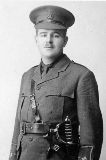
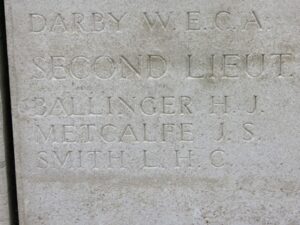
George Henry Davies, DCM, Sergeant, 52064, Cheshire Regiment. George was born in Aberystwyth in 1889, the son of John and Margaret Davies, of Pembroke House. He was educated at the County School, before enlisting at Holborn, London into the Royal Welsh Fusiliers. George was later transferred to the 13th Battalion, Cheshire Regiment, which was attached to 74 Brigade, 25th Division. George probably joined the Division after its move to the Warloy area, and took part in its attack on 3 July 1916 near Thiepval. The Division fought throughout the Battle of the Somme, and then moved to Ploegsteert, where it held the line for the months leading up the Battle of Messines in June 1917. George was killed in action by shellfire on 21 June 1917, just days after being awarded the Distinguished Conduct Medal for bravery. He was 28 years old, and is commemorated on the Ypres (Menin Gate) Memorial, Belgium.
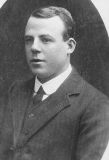
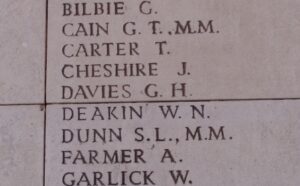
John Richard Davies, Private, 8546, Royal Welsh Fusiliers. Richard, known locally as Dick, was the son of Richard and Sarah Davies, of 1, Penglais Road, Aberystwyth. Dick played football for Aberystwyth Town FC and was a local postman who had who had served in India for seven years as a regular soldier. At the outbreak of war, he rejoined his regiment, the 2nd Battalion, Royal Welsh Fusiliers, and embarked for France, where it was attached to 19 Infantry Brigade, under independent command. The Brigade took part in the retreat from Mons to the Marne, where John rescued a wounded comrade under heavy fire at La Ferté-sous-Jouarre. The BEF then headed for Ypres, where 19 Brigade became attached to the 6th Division, and fought at the First Battle of Ypres. On 31 May 1915 the Brigade transferred to the 27th Division, and three months later transferred to the 2nd Division, taking part in the Battle of Loos. The 2nd RWF suffered terrible casualties at Loos, and remained in the Cambrin sector over the winter. On 15 March 1916, John was with ‘A’ Company, which was in the front line at the Brickstacks, when he was killed by a German rifle grenade. He was 29 years old, and is buried in Cambrin Military Cemetery, France.
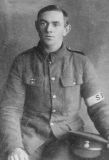
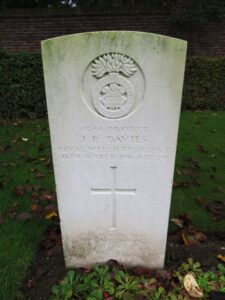
William Bailey Evans, Private, 39705, Welsh Regiment. William was born in 1896, the son of Captain William Evans of the Boar’s Head Hotel, Aberystwyth. He enlisted at Aberystwyth into the Welsh Regiment, and was posted to France late in 1916, joining the 15th Battalion, Welsh Regiment, which was known as the Carmarthen Pals battalion, attached to 114 Brigade, 38th (Welsh) Division. The Division had been in France since December 1915, and had taken part in the bloody capture of Mametz Wood in July 1916. The battered Welshmen had moved via Hébuterne to Boesinghe, on the Yser Canal, where it remained until launching its attack on Pilckem Ridge on 31 July 1917. After the successful capture of its objectives, the Division was withdrawn to rest, but the 15th Welsh remained in the line, in support of the Battle of Langemarck. William was killed in action here on 4 August 1917, aged 21, and is commemorated on the Ypres (Menin Gate) Memorial, Belgium.
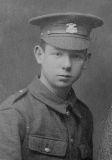
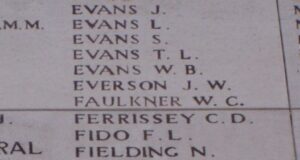
Oswald Robert John Green, Lieutenant, Welsh Regiment. Oswald was the son of William Arthur and Sophia Green of the Foundry, Aberystwyth, and the husband of Winifred Gwendoline Green, of Buchland House, Neath Abbey, Neath. George was educated at Jasper House and Aberystwyth University. He was a Holder of the Royal Humane Society Medal for life saving from drowning, and always to the fore in local sport, excelling swimming, cricket, golf and especially football. He was a successful captain of Aberystwyth Town Football Club prior to the war and spurned many offers to turn professional. A prominent trait was if any of the younger players was severely tackled, he always made a point of “protecting them”, a train of thought he was to take with him onto the battlefield. Oswald returned from America at the end of 1914 to take up a commission in the 9th Battalion, Welsh Regiment, which was attached to 58 Brigade, 19th (Western) Division. The Division moved to France during July 1915, and moved to positions near Loos, where it took part in the opening attack of the Battle of Loos on 25 September 1915. The following year the Division moved to the Somme, where it took part in the second wave of the attack on Ovillers-La Boiselle on 1 July 1916, capturing the village at heavy cost. The 9th Welsh had played a big part in the taking of Ovillers, but Oswald had been mortally wounded. He died on 5 July 1916, aged 35, as a result of his wounds, and is buried at Heilly Station Cemetery, Mericourt-L’Abbe, France.
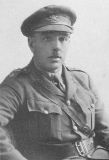
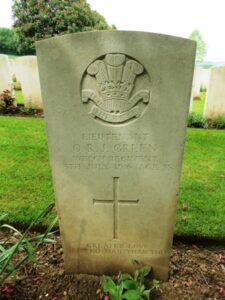
Richard Boycott Hinckesman, Lance Corporal, 497, King Edward’s Horse. Richard was born at Bridgenorth, Shropshire on 11 November 1886, the son of Thomas Boycott and Georgina Matilda Hinkesman (nee Vaughan). The family later resided at Tan y Graig, Trinity Road, Aberystwyth. An all round sportsman excelling at cricket and football, Richard played for Aberystwyth Town Football Club, before migrating to Canada. He returned home from Canada on 2 July 1914 to enlist into the King Edward’s Horse, a reserve Cavalry unit. It was mobilised on declaration of war and temporarily attached to 4th Cavalry Brigade. In April 1915, the regiment was split up, and the separate Squadrons attached to different Divisions. Richard died on 20 October 1915 while loading a wagon in a chalk pit, when a large pile of earth fell onto him. He had only recently been recommended for a commission. He was 28 years old, and is buried in Louvencourt Military Cemetery, France.
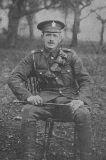
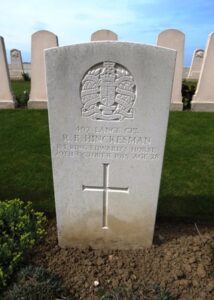
Thomas Hugh Hughes, Lance Corporal, 14851, South Wales Borderers. Thomas was born in 1898, the son of Thomas and Laura Hughes, of 12, Portland Road, Aberystwyth. He enlisted at Aberystwyth into the South Wales Borderers. He enlisted at Brecon on 8 November 1913, falsely declaring his age to be 18 years and 268 days, and joined the Royal Welsh Fusiliers. He was discharged on 30 January 1914 after his true age had been discovered, but Thomas was undeterred, and at the outbreak of war re-enlisted, and was posted to France, joining the 1st Battalion, South Wales Borderers, which was attached to 3 Brigade, 1st Division. Thomas joined the battalion at Ypres on 13 November 1914. He fought at the First Battle of Ypres that year, and remained with the battalion in Flanders over the winter. Thomas became an officers servant, probably after his age had been realised, and took part in the Battle of Neuve Chapelle the following year. He was killed in action at Cuinchy on 7 June 1917, just a month after his seventeenth birthday. Thomas was buried at Guards Cemetery, Windy Corner, France. His mother had only just received a letter from him stating that he hoped to be home in time for his birthday, on 1 May.
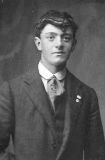
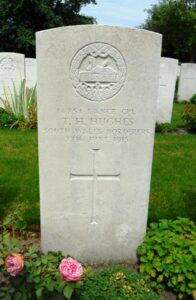
William Hazzelby Jones, Private, 42019, Welsh Regiment. William was the husband of Elizabeth Jones, of 8, Princess Street, Aberystwyth. He enlisted at Aberystwyth into the Welsh Regiment, and was posted to the 23rd Battalion, Welsh Regiment. The battalion was known as the Welsh Pioneers, and formed at Porthcawl in September 1915. In March 1916 it moved to Aldershot, becoming attached to the 69th Division, and on 13 July 1916 embarked at Devonport for Salonika, arriving on 24 August 1916, joining the 28th Division as its Pioneer Battalion. William wasn’t at the front long, as he became ill, and died of malaria on 1 December 1916, aged 39. William is buried in Lahana Military Cemetery, Salonika.
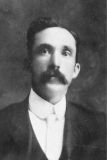
Archie Potts, Corporal, 18734, Welsh Regiment. Archie was born in 1896, the son of John and Anne Jane Potts, of Isledon, Trinity Place, Aberystwyth. He enlisted at Aberystwyth into the 15th Battalion, Welsh Regiment, which was known as the Carmarthen Pals battalion, attached to 114 Brigade, 38th (Welsh) Division. On 2 December 1915 the battalion moved to France, and the entire Division moved to the Fleurbaix sector, where it was initiated into trench warfare. During June 1916 the Division marched south to the Somme, and on 7 July 1916 attacked Mametz Wood. The initial attack failed, and it was three days later, on 10 July, that a fresh attack was mounted. After two days of heavy hand to hand fighting within the wood, the Germans withdrew, and the battered Welshmen moved via Hebuterne to Boesinghe, on the Yser Canal, where it remained until launching its attack on Pilckem Ridge on 31 July 1917. Archie was killed in action at Pilckem Ridge on 31 July 1917. He was 20 years old and is commemorated on the Ypres (Menin Gate) Memorial, Belgium.
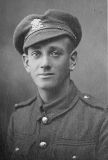
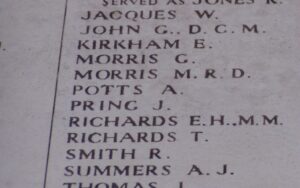
Thomas Stephenson, 25713, Battery Sergeant Major, Royal Field Artillery. Tom was born at Newark, Nottinghamshire in 1869. He married Bessie in 1901, and moved his family to Aberystwyth in 1912, where he became a postman, the couple residing at 13, Alexandra Road, Aberystwyth with their five children. Tom was an army pensioner who had served all over the empire during 18 years with the colours, and at the outbreak of war rejoined the Royal Field Artillery at Aberystwyth. He was posted to the 34th Division Ammunition Column, Royal Field Artillery on 4 May 1915. Tom didn’t move to France with the Division in January 1916 as he was starting to suffer from illness. He was invalided out of the army on 6 December 1916, and died at Aberystwyth on 13 August 1917, aged 47. Tom is not commemorated by the CWGC.
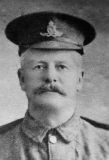
George James Vearey, Private, 29610, South, Wales Borderers. George was born in 1884, the son of James and Mary Vearey, of 17, Northgate Street, Aberystwyth. He married Margaret Ann Rees, of Half-Way Inn, Tre’rddol, Glandyfi at Aberystwyth in the summer of 1917, just before embarking for France, joining the 1st Battalion, South Wales Borderers. The battalion was on the Flanders Coast attached to 3 Brigade, 1st Division, and was preparing for an assault along the coast. After the Third Battle of Ypres had ground to a halt in the mud, the coastal operation was called off, and the 1st Division moved to Ypres. George was killed in action here during the Second Battle of Passchendaele, on 10 November 1917. He was 33 years old, and is commemorated on the Tyne Cot Memorial, Belgium.
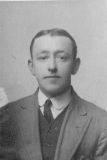
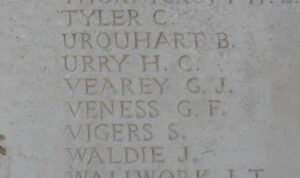
World War Two, 1939-1945
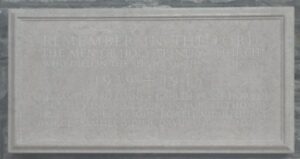
Robert John Beck, Fusilier, 834197, Royal Welch Fusiliers. Robert was born in Scarriff, Ireland in 1912, the son of William Beck and Louisa Agnes Beck (nee Davies). His father was an Irish ex-soldier, and his mother from Aberystwyth, and the family lived in Aberystwyth for many years prior to returning to Ireland, but had returned to Aberystwyth following Williams death in 1922. Robert had married Amy Thompson early in 1936, but sadly Amy died the following year. Robert was a regular soldier and served with the 1st Battalion, Royal Welch Fusiliers. The battalion was on the Belgian frontier at the outbreak of war, as part of the BEF, and saw heavy fighting during the withdrawal to Dunkirk, suffering terrible casualties prior to being evacuated. Robert was wounded during the withdrawal and carried aboard one of the evacuation ships. The ship was reportedly attacked by German aircraft and bombed during the return home on 31 May 1940, and Robert was killed in the attack. He was 28 years old, and is buried at Shorncliffe Military Cemetery, England.
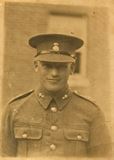
George Samuel Achille Didier, Officer Cadet, 798380, Royal Artillery. George was the son of Achille and Kate R. Didier, of Aberystwyth, and the husband of Lilian Didier. He was an Officer Cadet with the Royal Artillery, and served in North Africa. George died in Egypt on 13 December 1942, aged 27, and is buried at Heliopolis War Cemetery, Egypt.
Thomas Edward Evans, Leading Aircraftman, 1419519, Royal Air Force Volunteer Reserve. Thomas was the son of Evan Richard and Emmie Elizabeth Evans, of Aberystwyth. He served with the Royal Air Force and was posted to No. 1 Air Gunnery School. Thomas died at Aberystwyth on 6 January 1943, aged 19, and is buried at Aberystwyth Cemetery.
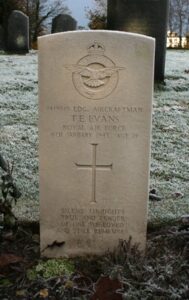
Gareth Pryse-Howell, Sergeant, 1282866, Royal Air Force Volunteer Reserve. Gareth was the son of John Pryse Howell and Phyllis Pryse Howell, of Aberystwyth. He enlisted into the Royal Air Force Volunteer Reserve and was posted to 1 TTU. Gareth was killed on 12 October 1942, whilst flying aboard a Handley Page Hampden I, Serial AN151 of Coastal Command, which crashed with the loss of all four of her crew. Gareth was 22 years old, and is commemorated on the Runnymede Memorial, Surrey. One other crew member is commemorated on the Runnymede Memorial, whilst the remains of the other two men were recovered.
David Thomas Jones, Aircraftman 1st Class, 1120283, Royal Air Force Volunteer Reserve. David was the son of William and Elizabeth Jones, of Aberystwyth, and the husband of Molly Jones, of Aberystwyth. He served with the Royal Air Force. David died on active service at Swansea on 12 April 1943, aged 35, and was brought home for burial at Aberystwyth Cemetery.
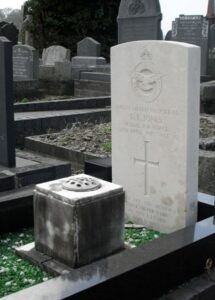
Louis Fleming Jones, M.A., Sub-Lieutenant, Royal Naval Volunteer Reserve. Louis was the son of Edward and Elizabeth Jones, of Aberystwyth. He served with the Royal Navy aboard H.M. Submarine Simoom. Simoom went on patrol from Port Said to the Aegean on 2 November 1943. Three days later she was diverted to the entrance of the Dardanelles Straits. She was supposed to have returned to port, but was never seen again. The Admiralty declared her as having officially been lost on 19 November 1943. The cause of her loss has never been verified. Louis was 24 years old when he died, and is commemorated on the Portsmouth Naval Memorial, Hampshire.
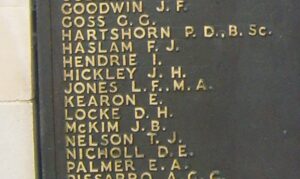
John Powell Middlehurst, MID, Flying Officer, 41605, Royal Air Force. John was the son of Richard Foster Middlehurst and Dorothy Elizabeth Middlehurst, of Aberystwyth, and the husband of Joan Middlehurst. He served in 113 Squadron, Royal Air Force, during which time he was mentioned in despatches. During the summer of 1941, the squadron was based in north Africa and were equipped with the Bristol Blenheim. Duties ranged from strafing enemy convoys, bombing airfields and enemy harbours. On 2 July 1941 John was flying aboard Blenheim IV, Serial V5928, when it was shot down and crashed into the Mediterranean off Mersa Matruh, Egypt, killing all three of her crew. John was 21 years old when he was killed that day and is commemorated on the Alamein Memorial, Egypt.
Bryan Robert Thomas, Sergeant, 1051799, Royal Air Force Volunteer Reserve. Bryan was the son of Edward Campbell Thomas, of Briarley, Iorwerth Avenue, Aberystwyth. He served as a Wireless Operator/ Air Gunner with 142 Squadron, Royal Air Force. In 1941 the squadron was flying the Vickers Wellington, on strategic night bombing missions. At around 18.30 on 21 October 1941 Bryan took off from RAF Binbrook aboard Wellington IV, Serial Z1210, which was part of a force despatched to bomb Bremen. The aircraft failed to return from the raid the following morning and was presumed to have crashed into the North Sea. Bryan was 29 years old when he was killed on 21 October 1941. He is buried in Sage War Cemetery, Germany. The cemetery in made up of many airmen, most of whom were lost in bombing raids over northern Europe, who were brought in from other cemeteries after the war were for reburial.